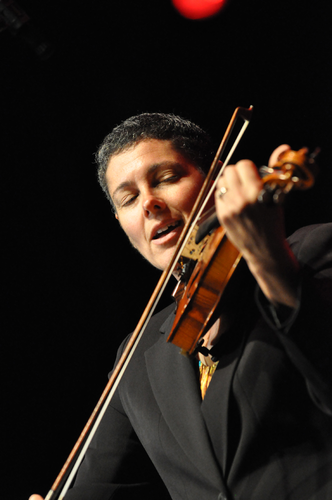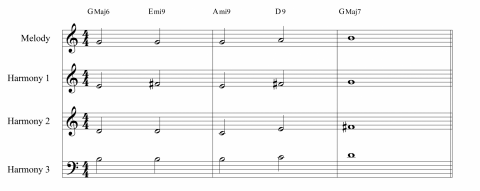Writing String Pads

Mimi Rabson plays violin and viola and is a professor in the Strings Department. She has toured with Itzhak Perlman's klezmer project and leads the Really Eclectic String Quartet.

My book explores the different roles strings can play in an ensemble. Strings can play the melody, add a countermelody, insert fills between melodic phrases, hold the harmony together with pads, comp with the rhythm section, and more. For this Woodshed session we will focus only on writing string pads.
String pads, the long notes or “goose eggs” that strings often play, can be the glue that gives an arrangement cohesion because strings can hold notes forever. Since they have infinite sustain, string sections are wonderful for presenting the harmonic content without interfering with the rhythmic or melodic content.
For the smoothest possible pads, ask your string players to stagger their bowing—i.e., make a point of changing bow direction at different times. With this technique, you won’t hear the interruption in sound that you would get when all the bows change direction at the same time. Include a down-bow mark and an up-bow mark next to each other to signify this for the players. Example 1 on page 27 shows how to indicate staggered bowing.
When choosing pitches for your pads, the sky is the limit. Clusters work, open voicings are also great, and parallel harmony is fantastic. Strings blend as beautifully as voices and S-A-T-B parts can be converted to violin 1, violin 2, viola, and cello. A string quartet can hold down the entire harmonic palette and a bass can be added to augment the low end. If you have only one string player to work with, write a line that adds harmony using chord tones. In example 2, the top line is the melody, and a harmony line could be played by a single violin, viola, or cello. Be sure your line has proper voice leading and can stand alone as an interesting melody. I should add the good voice leading is always important. Your musicians will play better and your writing will sound stronger if every line you write is singable and resolves properly.
If you’ve got two players accompanying a melody, have the strings play the guide tones. These notes, usually the third and seventh of the chord, give the chord its color and flavor. Example 3 is written for two accompaniment players. Once again, good voice leading makes a huge difference and is more important than making sure every guide tone is covered. In the second measure, note that I chose to leave out the ninth of the chord because there was no way to include it and achieve smooth voice leading. If I put the ninth in the lower part, the next interval skip would be a fourth. That’s not quite as elegant as the third, which was the interval skip in the first measure of the same part.
If the guide tones are played by other instruments or not required, you can use the strings to add tension notes outside the chord (the 9, 11, and 13) that can build the drama in your arrangement. Avoid voicing tensions and guide tones too low. It’s best to keep the tension notes above the G below middle C. The third of a chord can go as low as the E below middle C.
The way you voice your pads adds a lot to the arrangement. The octave surrounding middle C is neutral territory for voicing. It’s in the vocal range, and using tensions in this register is fine. Keeping the voicings close (within the span of an octave) is also somewhat neutral. Close voicings enable the listener to hear the color of the chord but not be distracted by it. This approach helps the melodic line come out. Example 4 shows string voicings for three accompaniment players.
As you move higher in pitch, the timbre of the strings adds more drama. Pads using the high notes of the violins tend to give the listener the feeling that they are suspended from above. But pads in the high register can also draw attention away from the melody. Careful use of dynamics can mitigate the potential problem. The lower registers of the viola and cello offer a more grounded, rooted sound.
Using wide voicings with a span of more than a tenth between the cello and the first violin is a great way to broaden the soundscape of your arrangement. Example 5 shows open voicings notated on a grand staff. The first three measures show close voicing and measures 4 to 6 show a wide range.
Example 6 shows the same passage in score form with violin 1 playing the melodic line. In measures 4 to 6, you can see that the upper voices are following the ascent of the melodic line to strengthen that motion. Note that the bass is always sounding the root. The viola plays double stops in bars 6 and 7. Sixth intervals are generally easy for string players to execute and keep in tune. If you have a large orchestra, you might want to mark the viola double stop divisi. That indicates that the violists should each take one of the notes.
When writing pads, it’s useful to think about how and when you want the players to use vibrato. Example 7 shows the way to indicate the way you want the players to use vibrato. To add drama, you might begin without vibrato (using the non vib notation) and then add vibrato gradually to enhance the peak of the story the music is telling. This idea may take some work in rehearsal since it’s not a common practice for classical string players.
Be sure to orchestrate so that the important parts of your arrangement will be heard. Sometimes orchestration is more effective than dynamics. Haydn rarely used dynamics in his string quartets because he didn’t need them. His orchestration is so brilliant, there is never any confusion about which part is in the forefront.
Careful use of dynamics with pads is a way to make sure the contour of your line goes as you want it to. Small hairpin dynamic markings as seen in example 8 can breathe life into a static line.
In the 1970s, the advent of polyphonic synthesizers made it possible for a keyboardist to play string pads in imitation of a string section. While synthesizers have improved since then, having live string players will always bring more excitement and musicality to any performance.
We’ve just covered the basics of string pads. The deeper you get into writing for strings, the more expressive devices you will discover that can enhance your music.

Example 1: Staggered bowing

Example 2: Single harmony line with chord tones

Example 3: String voicings for two accompanists

Example 4: String voicings for three accompanists

Example 5: String voicings in grand staff notation

Example 6: String voicings in score notation

Example 7: Variations in vibrato

Example 8: Variations in dynamics



